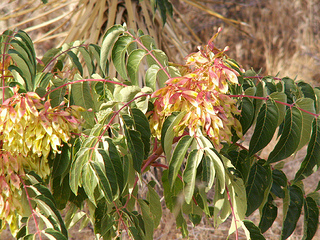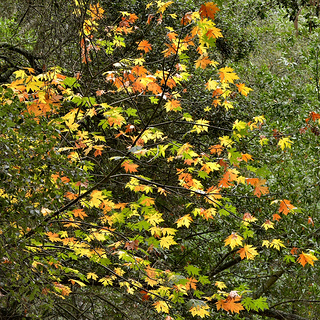 Ailanthus altissima. Photo © Dallas Masters.
Ailanthus altissima. Photo © Dallas Masters.
Tree-of-heaven (Ailanthus altissima), also known as Chinese sumac, is a deciduous tree native to northeast and central China and Taiwan. It was first introduced to North America in 1784 in Philadelphia, and became a popular ornamental tree commonly found in nurseries by the 1840s. Tree-of-heaven was also brought to California by Chinese immigrants during the Gold Rush. It is found throughout the continental United States and in Hawaii, and is reported as invasive in over 30 US states, including California. Tree-of-heaven is known for its “nutty” smell, and has large compound leaves that can have 10-41 leaflets; each leaflet has 1-2 teeth (edges) near its base. It can be commonly confused with native trees and shrubs such as sumacs, ash, hickory, black walnut, butternut and pecan, but these are distinguishable by their completely serrated leaflets.
Tree-of-heaven is especially successful at establishing around riparian areas, and changes streambed ecology by forming dense thickets that crowd out native plants, alter physical habitat, and produce chemicals that prevent other plants from establishing nearby. Tree-of heaven can also form extensive root systems that damage sewer systems and foundations. Established trees are incredibly difficult to eradicate because they can reproduce by sending out shoots, re-sprout from root fragments left in the soil, and female trees can produce up to 325,000 seeds in one year. Because tree-of-heaven is so efficient at re-sprouting, mechanical and manual removal is only effective against new, small trees, and usually must be repeated for a few seasons to be successful. The most effective strategy to remove established plants is with application of herbicide, and even this is not completely successful.
Since eradicating Tree-of-Heaven is so difficult, preventing its spread is a top priority for managing this invasive pest. You can help this effort by choosing not to plant tree-of-heaven as an ornamental tree in your yard. There are many beautiful plants native to California to choose from when planning your garden’s landscape, and below is one suggestion of an alternate tree to plant.
Native Alternative
 Acer macrophyllum. Photo © Marc Kummel.
Acer macrophyllum. Photo © Marc Kummel.
Big leaf maple (Acer macrophyllum) is a deciduous maple tree native to the Pacific coast, ranging from southern Alaska to southern California, and can be found in the foothills of the Sierra Nevada. It is commonly found in riparian hardwood forests and within open conifer canopies. Big leaf maple will grow quickly (as much as ten feet in the first year), and can reach heights up to 50 feet, but will usually be closer to 30 feet tall. If it is planted outside of its natural range, it will need a lot of water during its first year, but it can be drought tolerant once established. It tolerates clay and serpentine soils and seasonal flooding. Big leaf maple is a great alternative to tree-of-heaven because it provides shade in the summer and bright yellow and orange colors in the fall.